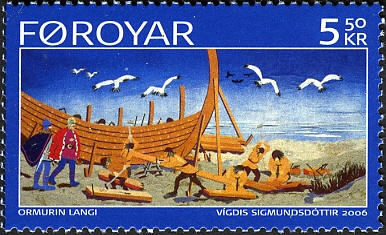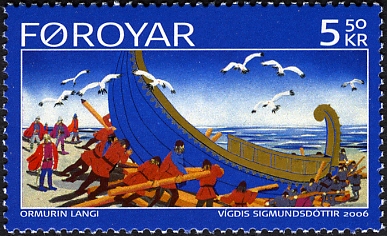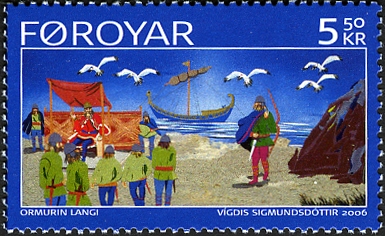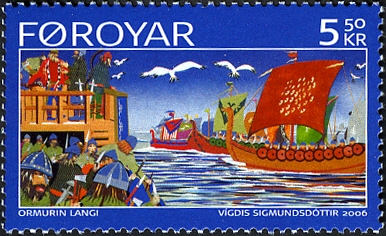



Around 1800 we see an increasing amount of attention being paid to the store of Faroese folk ballads, which survived in the oral tradition and were sung as an accompaniment to Faroese dancing. Even before 1800 J.C. Svabo had recorded ballads, but collecting got under way seriously after 1800, and names like J.H. Schrøter, Jóannes I Króki and later, V.U. Hammershaimb can be mentioned in this regard. The old ballads were seen as having special historical value, but there was also interest in more recent ballads, e.g. comic ballads, and new ballads were composed in the old style. One poet who attracts particular notice is Jens Christian Djurhuus (1773-1853), who was a farmer in Kollafjørõur. The most famous of his works is the “The Ballad of the Long Serpent”. His most individual work, however is perhaps “Púkaljómur (The Devil’s Ballad”), a religious epic based on Danish translation of “Paradise Lost” by the 17th century English poet John Milton. Otherwise he mainly takes the subject matter for his ballads from the Norse sagas, e.g. “Heimskringla” (The Chronicle of the Kings of Norway”) and “Færeyinga Saga”, the story of how the Faroes were converted to Christianity. This was the Romantic Age, and Norse literature was very much in vogue. Everything indicates that the Faroese immediately took his poetry to their hearts. In an account of a journey written in 1847-48 the ballad collector and clergyman V.U. Hammershaimb writes: “The old farmer Jens Christian Djurhuus of Kollafjørõur has composed many ballads based on the sagas. They have been very successful and are sung everywhere with pleasure, since their language is pure and they are very much in keeping with the old style; his ballad about Olaf Tryggvason or the battle at Svolder, the ballads about Sigmund and Leif, and this version of Milton’s Paradise Lost with its unusual metrical structure are particularly worthy of note.
“The Ballad of the Long Serpent” takes its subject matter from the account well given in “Heimskringla” of the famous sea battle off the island of Svolder or Swold in 1000, when the Swedish and Danish Kings, together with the Norwegian Erik Håkansons (Erik the Earl), attacked the Norwegian King, Olaf Trygvason, while he was on his way home from Wendland to Norway on his ship the LONG SERPENT, accompanied by his fleet. They attack in turn and King Olaf repulses the assaults of the two Kings, but is defeated by his countryman Erik Håkansson. The outcome of the battle is known: when Olaf realizes that the battle is lost, he leaps overboard together with his surviving men. It is not known where this battle took place, with it being doubtful whether there even was an island called Svolder. In the ballad the poet has Olaf sailing from the Baltic into the Oresund between Denmark and Sweden, where he imagines the island to be located, and the battle takes place in the straits between the island and the mainland.
Various scenes from the drama described in the ballad appear on ten stamps. We see the shipbuilding and launch, the king sitting on the throne while giving an audience to Einar the Archer, and we see the fleet put to sea. We see the LONG SERPENT and the other ships head into the straits while their adversaries stand on the shore watching them. In the LONG SERPENT’s bow we see Ulf the Red, Olaf’s forecastle man, while the king and Eric the Archer are seen up on the quarterdeck. We see dead bodies tumbling into the sea during the battle, which ends with Erik capturing the LONG SERPENT and so taking command of the vessel.
We do not know when ‘The Ballad of the Long Serpent’ was composed. The oldest recording dates back to 1819 and was made by Jóannes I Króki of Sandur. He also records it in 1823 in ‘Sandøbogen’ his large collection of ballads, together with the information that he had the ballad from the poet himself. When Svend Grundtvig and Jørgen Bloch edited ‘Føroya kvæõi’ an anthology of Faroese folksongs, around 1880, they knew of six recordings of the ballad. A recording in the poet’s own hand turned up at a later date, but we do not know when it dates from.
Nowadays the ballad is only referred to as ‘Ormurin Langi’, 1i.e. ‘The Long Serpent’, but that was not the title used by the poet himself. He called it ‘Olaf Trygvasons kvad’ (‘The ballad of Olaf Trygvason’), and we find the same title used by other recorders, including Jóannes I Króki. It is also the title used in ‘Føroya kvæõi’. It is not until a recording of 1846 that we find the ballad being named after the ship (‘Kvæõiõ um Ormin langa’)
When Hammershaimb had the ballad printed in his principal work. ‘Færøsk Anthologi’ (‘A Faroese Anthology’) of 1891, he used the title ‘Ormurin langi’, and the same title was used when it was serialized a few years earlier (1882) in the Dimmalætting newspaper. The text of the ballad varies slightly from recording to recording, but when the ballad is performed today, it is always in the form known from ‘Færøsk Anthologi’.
Nor do the old recordings agree on which refrain (and therefore which tune) to use. The refrain that reigns supreme today is only found in one of the oldest recordings. It is the one used in ‘Færøsk Anthologi’ and is incidentally, familiar from some of the old ballads.
‘Færøsk Anthologi’ has had a standardizing effect and its text has in some ways become the authorized version.
It would be no exaggeration to say that the ballad has become national property. All the Faroer Islanders know it, it is read and taught assiduously in schools, and most people-or at least those interested in Faroese dancing-can sing along when it is performed for a dance. It is well composed, the narrative is lively and hangs together logically, and the poetic language is powerful.
Source: Copied from Færøske frimærker.
